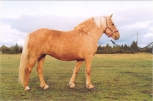Estonian Native Horse
Picture Gallery
Breed
The Estonian native horse is of type pacer. It is not large in size with low legs, long body and dry constitution light farming horse. Head is well proportional, with wide forehead, mostly straight, rarely concave profile, short ears, and frisky eye, brawny chap and wide gap between mandibles. Neck is relatively short side or medium in length, muscular and with dense crest. Withers is low-lying, muscular and with medium length. Back is wide and straight, seldom soft; loin is short wide and strong. Croup is muscular, plump, with medium length and width; tail is placed low and is thick. Thorax is wide and deep, costal good curved, stomach capacious. The legs are short, properly set and distinguished by firmness and cleanness with strong tendons and joints. The hoofs are regular and with hard, leaden coronet. As a fault, there is sometimes incorrect standing and sway back.
Analyse showed that the Estonian Native Horse is one of the few breeds, which has retained the characteristic features of the native horse and were not significantly influenced by crossing with other breeds.
The average measurement (in cm) are: stallions - height at withers 144.2, oblique body length 145.4, chest girth 169.8, cannon bone girth 18.9; mares 142.1-145.4–178.0–18.4 respectively. The measures of two-year-old young mares were 137.2-137.8-164.1-17.8 cm; and those of three-year-olds 139.3-141.8-172.0-18.4 cm and those of four-year-olds 141.0-143.9-172.5-18.3 cm.
The predominant colours are bay, chestnut, black and grey; there also occur dun, cream and mouse-dun. The changes in coat colours show, that the colour of a horse has become more important to the owner. A hundred years ago, most important was considered horses’ ability to work, but today a colourful horse is considered most “beautiful”. The number of grey horses is increasing and chestnut colour is decreasing (from 34.0% to 17.9%).
The character of Estonian native horse is live but peaceful, cheerful and sensible, temperament vigorous. The character of Estonian native horse is especially attractive due to the demanding character of ride-horses and disinterest of heavy-draught horses.
The Estonian native horse is well adapted to the local feeding and tenure circumstances and is unique by its modesty, good feed use and endurance. The most important ability of Estonian native horse is to live without concentrated fodder and that it does not need a proper stable for living in the snow less period.
Estonian native horse is known by its relatively great strength and speed.
Nowadays is the Estonian native horse universal little horse, which is used for light agricultural work, as a saddle horse for children and in tourism. It represents good breeding material for the production of ponies in various crosses.



